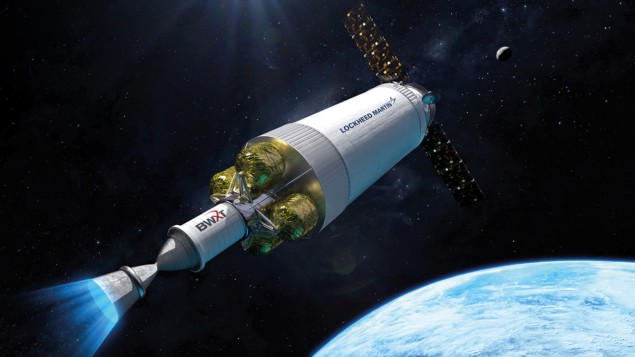Launching rockets into space with atomic bombs is a crazy idea that was thankfully discarded many decades ago. But as Richard Corfield discovers, the potential of using the energy from nuclear-powered engines to drive space travel is back on NASA’s agenda

In 1914 H G Wells published The World Set Free, a novel based on the notion that radium might one day power spaceships. Wells, who was familiar with the work of physicists such as Ernest Rutherford, knew that radium could produce heat and envisaged it being used to turn a turbine. The book might have been a work of fiction, but The World Set Free correctly foresaw the potential of what one might call “atomic spaceships”.
The idea of using nuclear energy for space travel took hold in the 1950s when the public – having witnessed the horrors of Hiroshima and Nagasaki – gradually became convinced of the utility of nuclear power for peaceful purposes. Thanks to programmes such as America’s Atoms for Peace, people began to see that nuclear power could be used for energy and transport. But perhaps the most radical application lay in spaceflight.
Among the strongest proponents of nuclear-powered space travel was the eminent mathematical physicist Freeman Dyson. In 1958 he took a year’s sabbatical from the Institute of Advanced Study in Princeton to work at General Atomics in San Diego on a project code-named Orion. The brainchild of Ted Taylor – a physicist who had worked on the Manhattan atomic-bomb project at Las Alamos – Project Orion aimed to build a 4000-tonne spaceship that would use 2600 nuclear bombs to propel it into space.
Dropping atomic bombs out of the back of a spacecraft sounds crazy on environmental grounds, but Dyson calculated that “only” 0.1–1 Americans would contract cancer from this method. The project was even backed by rocket expert Wernher von Braun, and a series of non-nuclear test flights were carried out. Thankfully, the 1963 Partial Test Ban Treaty put an end to Project Orion, and Dyson himself later withdrew his support for atomic spacecraft after belatedly recognizing their environmental hazards.
Despite Project Orion ending, the lure of nuclear propulsion never really went away (see box “Nuclear space travel: a brief history”) and is now enjoying something of a resurgence. Rather than using atomic bombs, however, the idea is to transfer the energy from a nuclear fission reactor to a propellant fuel, which would be heated to roughly 2500 K and ejected via a nozzle in a process called “nuclear thermal propulsion” (NTP). Alternatively, the fission energy could ionize a gas that would be fired out of the back of the spacecraft – what’s known as “nuclear electric propulsion” (NEP).
So, is nuclear-powered space travel a realistic prospect and, if so, which technology will win out?
Nuclear space travel: a brief history

The idea of nuclear-powered spaceflight dates back to the 1950s when the physicist Freeman Dyson proposed using atomic bombs to propel rockets into space. That notion was thankfully and swiftly abandoned, but in the 1960s and 1970s, NASA and the US Atomic Energy Commission ran the Nuclear Engine for Rocket Vehicle Application (NERVA) programme, which aimed to use the heat from a fission reaction to propel a rocket into space. Although a nuclear mission was never launched, NERVA did lead to several advances in reactor design, fabrication, turbomachinery and electronics.
Later, in the 1980s, the US set up the $200m Space Nuclear Thermal Propulsion (SNTP) programme, which sought to develop nuclear-powered rockets that would be twice as powerful as traditional chemical rocket engines. SNTP was part of the US Strategic Defense Initiative, which President Ronald Reagan had set up to protect America from incoming nuclear missiles. SNTP was abandoned in the early 1990s as the fuel elements tended to fracture under stress and the propulsion system testing was deemed too expensive. Now, however, NASA is looking once again at nuclear space travel (see main text).
Nuclear boost
Most conventional rockets are powered by ordinary, chemical fuels. The Saturn V rocket that took astronauts to the Moon in the late 1960s and early 1970s, for example, used liquid fuels, while the rocket boosters that failed so spectacularly during the launch of the space shuttle Challenger in 1986 contained solid fuel.
More recently, Space X’s Falcon rockets, for example, have used a mix of kerosene and oxygen. Trouble is, all such propellants have a relatively small “energy density” (energy stored per unit volume) and a low “specific impulse” (the efficiency with which they can generate thrust). This means that the overall thrust of the rocket – the specific impulse multiplied by the mass flow rate of the exhaust gas and Earth’s gravity – is low.
Chemical propellants can therefore only get you so far, with the Moon being the traditional limit. To reach distant planets and other “deep-space” destinations, spacecraft usually exploit the gravitational pull of multiple different planets. Such journeys are, however, circuitous and take a long time. NASA’s Juno mission, for example, needed five years to get to Jupiter, while the Voyager craft took more than 30 years to reach the edge of the solar system. Such missions are also restricted by narrow and infrequent launch windows.
A nuclear spacecraft would instead use fission energy to heat a fuel (figure 1) – most likely cryogenically stored liquid hydrogen, which has a low molecular mass and high heat of combustion. “Nuclear propulsion, either electric or thermal, could extract more energy from a given mass of fuel than is possible via combustion-based propulsion,” says Dale Thomas, a former associate director at NASA’s Marshall Space Flight Center, now at the University of Alabama in Huntsville.
1 Inside a nuclear-powered spacecraft

In a rocket using nuclear thermal propulsion, a working fluid, usually liquid hydrogen, is heated to a high temperature in a nuclear reactor and then expands through a nozzle to create thrust. Providing a higher effective exhaust velocity, such a rocket would double or triple payload capacity compared to chemical propellants that store energy internally.
Thomas says that today’s most efficient chemical propulsion systems can achieve a specific impulse of about 465 seconds. NTP, in contrast, can have a specific impulse of almost 900 seconds due to the higher power density of nuclear reactions. Combined with a much higher thrust-to-weight ratio, NTP could get a rocket to Mars in just 500 days, rather than 900.
“The thrust-to-weight ratio is crucial because it determines the spacecraft’s ability to accelerate, which is especially critical during key mission phases, like escaping Earth’s gravity or manoeuvring in deep space,” says Mauro Augelli, head of launch systems at the UK Space Agency. “The specific impulse, on the other hand, is a measure of how effectively a rocket uses its propellant.”
Nuclear propulsion, either electric or thermal, could extract more energy from a given mass of fuel than is possible via combustion-based propulsion
Dale Thomas, University of Alabama in Huntsville
Essentially, for a given amount of propellant, a nuclear-powered spacecraft could travel faster and sustain its thrust for longer periods than a chemical rocket. It would therefore be great for crewed missions to Mars – not only would the astronauts have a quicker journey, but as a result of that, they’d be exposed to less cosmic radiation. “Moreover, shorter mission durations reduce the logistical and life-support challenges, making deep-space exploration more feasible and safer,” Augelli adds.
But nuclear power is not just about cutting journey times. NASA also has a dedicated programme at its Glenn Research Center in Cleveland, Ohio, to use nuclear fission – rather than solar energy or chemical fuels – to power spacecraft once they have reached their destination. “Nuclear energy offers unique benefits for operating in extreme environments and regions in space where solar and chemical systems are either inadequate or impossible as power sources for extended operation,” says programme manager Lindsay Kaldon.
Back in action
In 2020 the US government put nuclear spacecraft firmly back on the agenda by awarding almost $100m to three firms – General Atomics, Lockheed Martin and Blue Origin. They will use the money to work on the Demonstration Rocket for Agile Cislunar Operations (DRACO) programme, which is funded via the DARPA research agency of the US Department of Defense. In the first phase, the companies will aim to show that NTP can be used to fly a rocket above low-Earth orbit, with DARPA aiming for thrust-to-weight ratios on par with existing chemical rocket systems.

Tabitha Dodson, DARPA programme manager for DRACO, thinks that the successful launch and flight of a nuclear space reactor by the DRACO programme would revolutionize space flight. “Unlike today’s chemical systems, which have reached a limit in how far they can evolve, nuclear technologies are theorized to evolve to systems such as fusion and beyond,” she says. “Spacecraft evolved to be manoeuvred and powered by nuclear reactors will enable humanity to go farther, with a higher chance of survival and success for any mission type.”
In the DRACO programme, General Atomics will design the NTP reactor and draw up a blueprint for a propulsion subsystem, while Blue Origin and Lockheed Martin will plan the spacecraft itself. The fission reactor would use a special high-assay low-enriched uranium (HALEU), which can be made using fuel recycled from existing nuclear reactors. Containing only 20% enriched uranium, it is unsuitable for being turned into nuclear weapons.
The reactor would not be turned on (i.e. go critical) until the craft had reached a “nuclear-safe” orbit. In the unlikely event of an emergency, any contamination would, in other words, be harmlessly dissipated into space. Lockheed Martin has already joined forces with BWX Technologies of Lynchburg, Virginia, to develop the reactor and produce the HALEU fuel. BWX says that a DRACO rocket could launch as soon as 2027.

Air-breathing rocket engines: the future of space flight
Elsewhere, researchers at Idaho National Laboratory in the US are helping NASA develop and test the materials needed for a nuclear rocket at its Transient Reactor Test (TREAT) facility near Idaho Falls. They already carried out a practice run last year to validate the computer models and test a new sensor and experiment capsule. Long-term, the aim is to identify which materials, composite structures and uranium compounds work best in the extremely hot conditions of an NTP reactor.
The heat from the reactor would heat hydrogen fuel, which provides the biggest change in velocity – what rocket scientists call Δv – for a given mass. The downside of hydrogen is that it has a low density and the rocket would need large tanks. Other propellants, such as ammonia, have a lower Δv per kilogram of propellant, but are much more dense. Over at Huntsville, Thomas has shown that ammonia would be the ideal fuel to get astronomers to Mars from NASA’s Lunar Gateway – a space station that would orbit the Moon.
Having published a review of NTP technology for the American Institute of Aeronautics and Astronautics in 2020, Thomas has concluded that regular NTP systems, which offer lots of thrust for short burns of about 50 minutes, will be ideal for flybys and rendezvous missions. But there are also “bi-modal” systems, which combine NTP with NEP (see box “The challenges of nuclear electric propulsion”). The former gives quick bursts of high thrust while the latter yields low thrust for longer periods – perfect for lengthy, round-trip missions.
Kate Haggerty Kelly, director of space and engineering at BWX Technologies, says that overall nuclear thermal propulsion can be two to five times more efficient than chemical propulsion systems while also offering high thrust. “[In contrast], nuclear electric propulsion systems can provide higher efficiencies but lower thrust, and the energy generated through nuclear fission can be converted to electricity to provide power to subsystems on the spacecraft.”
The challenges of nuclear electric propulsion

Nuclear thermal propulsion (NTP) involves using the energy from a nuclear reaction to heat fuel that’s fired out of the back of a rocket, like the air from a toy balloon. But with nuclear electric propulsion (NEP), the fission energy is instead used to ionize a gas. “The propellant expelled by a NEP system can be an inert gas, such as xenon or krypton, but iodine, lithium or hydrogen can be options depending on the type of electric thruster,” says Lindsay Kaldon, project manager of fission surface power at NASA’s Glenn Research Center.
As the propellant is ionized, the gas can be guided and accelerated using electromagnetic devices to give a spacecraft its forward motion. Kaldon admits that the amount of thrust is far less than you’d get from an NTP rocket. “Think of NEP as a sailboat with a slight breeze compared to a speedboat,” she says. “However, this is really all we need for a steady, reliable trip into deep space.”
The challenge for Kaldon and her colleagues at Glenn is to ensure that the reactor is producing enough electricity to ionize the propellant and that the thrusters are functioning smoothly. One option is to use a “Stirling engine”, which uses the cyclic compression and expansion of gas between a hot and cold end of the engine to produce electricity. The other option is a “Hall effect thruster”, which creates a voltage by combining an electrical conductor with a magnetic field perpendicular to the conductor.
So will NTP or NEP be better for deep-space operations? According to Thomas, it will depend on the type of mission. “For missions of a certain class – such as scientific spacecraft above a certain mass – or crewed missions, or for certain destinations, NTP will be the best choice, whereas for other missions NEP will be best. Like a car journey, it depends on the distance, how much baggage you are carrying, your schedule demands and so forth.”
Nuclear future
NASA is already considering several nuclear-powered space missions. According to a report released in June 2021, these could include craft that will orbit various moons of Uranus and Jupiter, and others that will orbit and land on Neptune’s moon Triton. The report also envisages a nuclear-powered rocket entering a polar orbit around the Sun and possibly even a mission into interstellar space.
In the final analysis, nuclear propulsion of some type will – either alone or combined with another type of propulsion – be an important part of humanity’s future space efforts. With NASA, the UK Space Agency and the European Space Agency all looking at nuclear-powered spaceflight, my bet is that the first crewed missions to Mars will, by the 2030s, use some form of this technology. The dream of Freeman Dyson could, I am sure, soon see the light of day.
- SEO Powered Content & PR Distribution. Get Amplified Today.
- PlatoData.Network Vertical Generative Ai. Empower Yourself. Access Here.
- PlatoAiStream. Web3 Intelligence. Knowledge Amplified. Access Here.
- PlatoESG. Carbon, CleanTech, Energy, Environment, Solar, Waste Management. Access Here.
- PlatoHealth. Biotech and Clinical Trials Intelligence. Access Here.
- Source: https://physicsworld.com/a/nuclear-powered-spacecraft-why-dreams-of-atomic-rockets-are-back-on/



